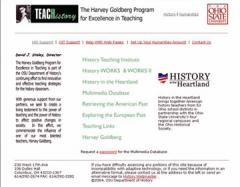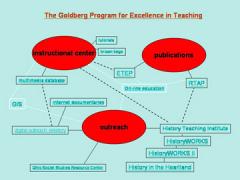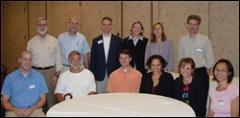|
|
Summary Description We
have a four-point structure to guide our graduate students through the
art of teaching and to socialize them into the profession. Pedagogical material is focused within: a
year-long course required for all first-year Teaching Associates,
addressing topics such as organizing effective discussion sections,
techniques of grading and presentation, the role of a textbook,
theories of learning and diversity in the classroom and the Departmental course on historiography, helping students articulate the variety, procedures and limitations of "history." Practical
experience involves a progression of assignments culminating after
candidacy exams in complete responsibility for survey courses. Faculty
serve as mentors throughout. Exposure outside the Department, particularly in OSU's Preparing Future Faculty Program.
OSU Preparing Future Faculty Program
|
|

The Goldberg Program for Excellence in Teaching
|
Resources The fourth element is the wealth of resources we make available: syllabi and files of textbook evaluations and other course information a booklet of guidelines and tips for TAs seminars and colloquia University teaching development resources visits by groups of publisher representatives encouragement of faculty actively to train TAs in their duties. Yet
the heart of the many resources we offer to our graduate students as
teachers lies in the Department's Goldberg Program for Excellence in
Teaching. This website page lists the major elements of the Program, which is directed by Dr. David Staley.
Goldberg Program
|
|
|

The three enterprises
|
This
"wiring diagram" indicates how the three key initiatives of the Program
interact to reinforce and invigorate one another. The
outreach elements of the Program include the History Teaching Center,
composed of HistoryWORKS, HistoryWORKS II and History in the Heartland.
These are all U.S. Department of Education funded partnerships with our
Department, the Ohio Historical Society and school districts in the
city and central Ohio areas. For further information, click twice on the link below.
Goldberg Program
|
|
|
Goals for Students be comfortable with and competent to discuss a variety of methods, contents, contexts, viewpoints and cultures intelligently
read primary sources in the language and style of the time in which
they were generated and convey the living sense of those materials to
students handle new technologies and the opportunities they offer for teaching as well as research. construct unique and reliable interpretations of the past in the classroom place a variety of arguments and conclusions before their students skillfully convey basic and advanced information and interpretations communicate with broader publics and make connections among these understand the methodological and ethical norms of the profession, and abide by them in all endeavors related to students.
|
|
|
Program Context We
historians are in the context business: our fundamental concern is with
the changing contexts of human existence and interaction over the past
7,000 years. We believe that all human experience and interaction are
deeply historical. The
teaching elements of our Graduate Program are designed less to download
information than to replace an empty mind with an open one. Teaching
is a traditional element of "scholarship." The difference between
teaching and research lies in the depth of documentation and
interpretation appropriate to a classroom or professional audience. Many
of the same communications strategies are used in both venues. Students
need to respond to questions that animate an audience, defend their
choices and conclusions, and face critique with poise--in person or on
the page. Students
must also be able to develop and pass on research techniques to
graduate students of their own. Teaching and research/publication are
both about asking intelligent questions. They are thus partners in our
Graduate Program.
|
|
|
Reflections Kevin Boyle, a Department colleague who won this year's National Book Award for Arc of Justice, reflects in a media-player video clip on the relation between his teaching and his research. In both, he tells us, what matters is the power of a story. Click on the link below.
Kevin Boyle
|
|
|
|
How Do We Know? We monitor the progress of our students throughout the process of honing their teaching skills: faculty prepare reports on the graders and discussion section leaders advisors serve as resource persons for the Small Section Leaders University student evaluations in every class University Faculty and Student Development offers videotaping and professional evaluators Department teaching award to a TA each year University annual Outstanding Teaching Associate award program. We
keep track of alumni, and seek informal feedback from colleagues
elsewhere. The word in the hiring market is that our students shine in
relation to the competition, but we have no formal means of independent
evaluation. Perhaps we should develop one.
|
|

CID Leadership Team
|
Unanswered Questions Our proposed changes were formally adopted by the Department in May and June. The
CID Team will remain in existence another year to consider patterns of
change in the profession and look for ways to anticipate developments
over the coming decade. The
Goldberg Program offers us a unique opportunity to explore the impact
of information technologies in the classroom and in research. In teaching: beyond video games and reenactments historical simulation as a form of "lab exercise" from tourists to travelers. In research: visualization techniques becoming commonplace in other fields GIS programs to layer statistical data and then "see" or "mine" that data architecture reconstruction programs and studies in material culture possibilities both for research and for our graduate education. New program opportunities: an M.A. or Ph.D. field in "new media" history.
|
|
|
Contact Information Alan Beyerchen, Graduate Studies Chair and Leader of CID Leadership Team beyerchen.1@osu.edu Melissa Guy, Graduate Student member of CID Leadership Team guy.67@osu.edu
|
|
|